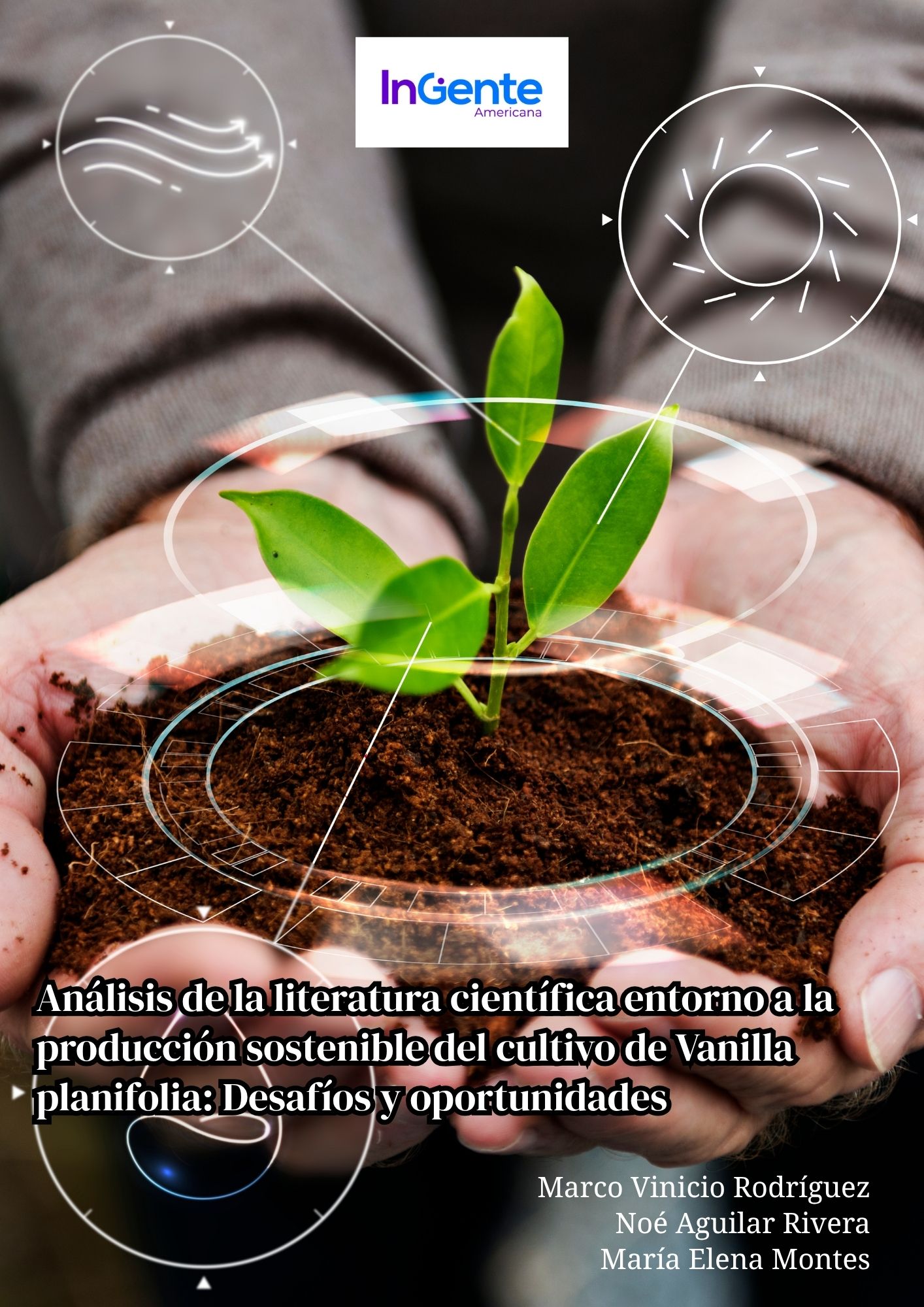Análisis de la literatura científica entorno a la producción sostenible del cultivo de Vanilla planifolia: Desafíos y oportunidades
DOI:
https://doi.org/10.21803/ingecana.5.5.972Palabras clave:
Bibliometría, diversificación de cultivos, sostenibilidad agrícola, vainilla de calidadResumen
Vanilla planifolia es una orquídea de hábito trepador y principal fuente natural de vainillina, utilizada en diversas industrias. La bibliometría permite analizar la evolución y las brechas en la investigación. El análisis se realizó utilizando los términos "vanilla" y "sustainable" en publicaciones entre 2002 y 2025. Se utilizó Scopus y VOSviewer para construir gráficos estadísticos y mapas de concurrencia. Se estipulo un umbral de tres documentos por país y tres repeticiones por término. La literatura científica ha tenido un crecimiento notable en 2023. A nivel global, 29 países han contribuido, destacando Estados Unidos e India. A pesar de la importancia de la vainilla en Latinoamérica, la producción científica es limitada. Términos como diversificación de cultivos y aprendizaje colaborativo han ganado relevancia, lo que sugiere un enfoque en la sostenibilidad agrícola. Es indispensable fomentar entre las naciones la implementación de sistemas agrícolas sostenibles que garanticen una producción de vainilla de calidad
Descargas
Referencias
[1] Divakaran, M. Suseela, R., Menchaca, R., Aarthi, S. Devasahayam, S., Nirmal, K. and Sudarshan, M. R. “Vanilla. In Handbook of Spices in India: 75 Years of Research and Development” Singapore: Springer Nature Singapore pp. 2591-2685, 2024.
[2] Banerjee, G. and Chattopadhyay, P. “Vanillin biotechnology: the perspectives and future”. Journal of the Science of Food and Agriculture, 99(2), pp. 499-506. 2019.
[3] Flores, O. Cuéllar, J. F. Montes, M. E. Gámez, M. R. González-Arnao, M. T. Guevara, M. and Aguilar-Rivera, N. “Germinación in vitro de semillas de Vanilla planifolia Jacks y comparación de métodos de micropropagación”. AIA 21(2), pp. 69-83, 2017.
[4] Olatunde, A. Mohammed, A. Ibrahim, M. A. Tajuddeen, N. and Shuaibu, M. N. “Vanillin: A food additive with multiple biological activities”. European Journal of Medicinal Chemistry Reports, 5, 100055, 2022.
[5] Singh, N. and Sudha, M. L. “Natural food flavours: a healthier alternative for bakery industry—a review”. Journal of food science and technology, 61(4), pp. 642-650 2024.
[6] Andrade-Andrade, G. Delgado-Alvarado, A. Herrera-Cabrera, B. E. Arévalo-Galarza, L. and Caso-Barrera, L. “Variation of phenolic compounds, flavonoids and tannins in Vanilla planifolia Jacks. ex Andrews in the Huasteca Hidalguense, Mexico”. Agrociencia, 52(1), pp. 55-66, 2018.
[7] Kaur, K. Sharma, R. and Singh, S. “Bioactive composition and promising health benefits of natural food flavors and colorants: potential beyond their basic functions”. Pigment & resin technology, 49(2), pp. 110-118, 2020.
[8] Hernández‐Hernández, J. “Mexican vanilla production”. Handbook of Vanilla science and technology, pp. 1-26, 2018.
[9] Singletary, K. W. “Vanilla: potential health benefits”. Nutrition Today, 55(4), pp. 186-196, 2020.
[10] Iannuzzi, C. Liccardo, M. and Sirangelo, I. “Overview of the role of vanillin in neurodegenerative diseases and neuropathophysiological conditions”. International journal of molecular sciences, 24(3), 1817, 2023.
[11] Ahmad, H. Khera, R. A. Hanif, M. A. Ayub, M. A. and Jilani, M. I. “Vanilla. In Medicinal plants of South Asia”, Elsevier, pp. 657-669, 2020.
[12] Gallage, N. J. and Møller, B. L. “Vanilla: The most popular flavour”. In Biotechnology of natural products, Cham: Springer International Publishing, pp. 3-24, 2017.
[13] Teoh, E. S. “The Story of Vanilla. In: Orchids as Aphrodisiac”, Medicine or Food. Springer, Cham, 2019.
[14] Karremans, A. P. A “Historical review of the artificial pollination of Vanilla planifolia: the importance of collaborative research in a changing world”. Plants, 13(22), 3203, 2024.
[15] D’Arrigo, P. Rossato, L. A. Strini, A. and Serra, S. “From waste to value: recent insights into producing vanillin from lignin”. Molecules, 29(2), 442, 2024.
[16] Remaud, G. S. Thomas, F. and Akoka, S. “Contribution of Position-Specific Isotope Analysis for Characterizing the Origin of Vanillin: Keeping One Step Ahead of the Fraudster”. In Handbook of Isotopologue Biogeochemistry, Singapore: Springer Nature Singapore, pp. 1-31, 2023.
[17] Kalantari, A. Kamsin, A. Kamaruddin, H. S. Ale Ebrahim, N. Gani, A. Ebrahimi, A. and Shamshirband, S. “A bibliometric approach to tracking big data research trends”. Journal of big data, 4, pp. 1-18, 2017.
[18] Robusti, C. D. S. and Farina, M. C. “Advances and applications of Biotechnology in Agribusiness: an analysis of scientific production”. Em Questão, 31, e-141487, 2025.
[19] Armenta-Montero, S. Menchaca-García, R. Pérez-Silva, A. and Velázquez-Rosas, N. “Changes in the potential distribution of Vanilla planifolia Andrews under different climate change projections in Mexico”. Sustainability, 14(5), 2881, 2022.
[20] Barreda-Castillo, J. M. and Menchaca, R. “Prospects in Vanilla (Vanilla planifolia Andrews) production in Mexico in relation to temperature fluctuations”. Agro Productividad. 2024.
[21] Barragán-Ocaña, A. Silva-Borjas, P. and Cecilio-Ayala, E. “Vanilla production in the world and Mexico: Market value and technology”. Social Sciences & Humanities Open, 10, 101076, 2024.
[22] Sikarwar, P. S. Vikram, B., Sengupta, J. D. Singh, A. Kumar, N. Mishra, A. and Kumar, V. “Vanilla: A Review of Powerful Herb with Ayurvedic Medicinal Properties”. Int. J. Environ. Clim, 14, pp. 809-817, 2024.
[23] Kumar, A. Singh, V. Mishra, A. K. Singh, H. Parvez, S. and Khan, G. “Synthesis, characterization and computational studies of some new vanillin derivatives for cosmetic purpose”. Journal of Molecular Structure, 1327, 141127, 2025.
[24] Rodríguez-Deméneghi, M. V. Rivera, N. A., Gheno-Heredia, Y. A. and Armas-Silva, A. A. “Vanilla cultivation in Mexico: typology, characteristics, production, agroindustrial prospective and biotechnological innovations as a sustainability strategy”. Scientia Agropecuaria 14 (1), pp.93-109, 2023.
[25] Watteyn, C. Dejonghe, O. Van Hoyweghen, K. Bolaños, J. B. A. Karremans, A. P. Vranken, L. and Maertens, M. “Exploring farmer preferences towards innovations in the vanilla supply chain”. Journal of Cleaner Production, 330, 129831, 2022.
[26] Iftikhar, T. Majeed, H. Waheed, M. Zahra, S. S. Niaz, M. and AL-Huqail, A. A. “Vanilla. In Essentials of medicinal and aromatic crops”, Cham: Springer International Publishing, pp. 341-371, 2023.
[27] Lubinsky, P. Romero‐González, G. A. Heredia, S. M. and Zabel, S. (Eds.). “Origins and patterns of vanilla cultivation in tropical America (1500–1900): no support for an independent domestication of vanilla in South America”. Handbook of vanilla science and technology, pp. 121-145, 2018.
[28] de Oliveira, R. T. da Silva Oliveira, J. P. and Macedo, A. F. “Vanilla beyond Vanilla planifolia and Vanilla× tahitensis: Taxonomy and historical notes, reproductive biology, and metabolites”. Plants, 11(23), 3311, 2022.
[29] Arya, S. S. Mahto, B. K. Sengar, M. S. Rookes, J. E. Cahill, D. M. and Lenka, S. K. “Metabolic engineering of rice cells with vanillin synthase gene (VpVAN) to produce vanillin”. Molecular biotechnology, 64(8), pp. 861-872, 2022.
[30] Lou, M. Li, S. Jin, F. Yang, T. Song, R. and Song, B. “Pesticide engineering from natural vanillin: Recent advances and a perspective”. Engineering, 2024.
[31] Quinteros-Gómez, Y. Cabrera Mestanza, D. Macedo-Bedoya, J. Santos-Linares, V. and Salinas-Inga, A. “Vegetative propagation of Vanilla pompona subsp. grandiflora (Orchidaceae) in floodplain territories of the Alto Mayo Valley, Peru”. Acta botánica mexicana, pp. 131, 2024.
[32] Ellestad, P. Forest, F. Serpe, M. Novak, S. J. and Buerki, S. “Harnessing large-scale biodiversity data to infer the current distribution of Vanilla planifolia (Orchidaceae)”. Botanical Journal of the Linnean Society, 196(3), 407-422, 2021.
[33] Hending, D. Andrianiaina, A. Maxfield, P. Rakotomalala, Z. and Cotton, S. “Floral species richness, structural diversity and conservation value of vanilla agroecosystems in Madagascar”. African Journal of Ecology, 58(1), pp. 100-111, 2020.
[34] Chambers, A. H. “Vanilla (Vanilla spp.) breeding. Advances in Plant Breeding Strategies”, Industrial and Food Crops: Volume 6, pp. 707-734, 2019.
[35] Wahyudi, A. Sujianto, S. and Kurniasari, I. “Strategy for developing Indonesian vanilla products to improve the added value”. In IOP Conference Series: Earth and Environmental Science, IOP Publishing; Roy Vol. 892, pp. 012042, 2021.
[36] González-Arnao, M. T. Cruz-Cruz, C. A. Hernández-Ramírez, F. Alejandre-Rosas, J. A. and Hernández-Romero, A. C. “Assessment of vegetative growth and genetic integrity of vanilla planifolia regenerants after cryopreservation”. Plants, 11(13), 1630, 2022.
[37] Rasoamanalina, R. O. L., Mirzaei, K. El Jaziri, M., Rasamiravaka, T. Ramarosandratana, A. V. and Bertin, P. “Genome-wide assessment of genetic variation and population structure in cultivated vanilla from Madagascar”. Genetic Resources and Crop Evolution, pp. 1-17, 2024.
[38] Velázquez-Rosas, N. Sinaca Colin, S. Vázquez-Domínguez, G. Velasco-Murguía, A. Silva Rivera, E. Ruiz-Guerra, B. and Martínez-Mota, R. “Importance of Traditional Vanilla Cultivation in the Conservation of Plant Diversity in Tropical Forests in Northern Veracruz, Mexico”. Sustainability, 17(6), 2598, 2025.
[39] Brauer, C. Trinidad-García, K. Parra-Rodriguez, O. and Reyes-Hernández, H. “Sustainable vanilla pod dryer for small scale producers based on a participatory learning process”. Energy for Sustainable Development, 78, 101366, 2024.
[40] Watteyn, C. Fremout, T., Karremans, A. P. Huarcaya, R. P. Azofeifa Bolanos, J. B. Reubens, B. and Muys, B. “Vanilla distribution modeling for conservation and sustainable cultivation in a joint land sparing/sharing concept”. Ecosphere, 11(3), e03056, 2020.
[41] Borbolla-Pérez, V., Iglesias-Andreu, L. G., Luna-Rodríguez, M., & Octavio-Aguilar, P. “Perceptions regarding the challenges and constraints faced by smallholder farmers of vanilla in Mexico”. Environment, Development and Sustainability, 19, pp. 2421-2441, 2017.
[42] Ma, J. and Cheng, Y. “Why do some academic articles receive more citations from policy communities?”. Public Administration Review., 2024.
[43] Sollen-Norrlin, M. Ghaley, B. B. and Rintoul, N. L. J. “Agroforestry benefits and challenges for adoption in Europe and beyond”. Sustainability, 12(17), 7001, 2020.
[44] Martău, G. A. Călinoiu, L. F. and Vodnar, D. C. “Bio-vanillin: Towards a sustainable industrial production”. Trends in Food Science & Technology, 109, pp. 579-592, 2021.
[45] Brown, M. L. “Madagascar’s cyclone vulnerability and the global vanilla economy” Altamira Press: New York, pp. 241-264, 2009.

Descargas
Publicado
Número
Sección
Licencia
Derechos de autor 2025 Marco Vinicio Rodríguez Deméneghi, Noé Aguilar Rivera, María Elena Montes

Esta obra está bajo una licencia internacional Creative Commons Atribución 4.0.





